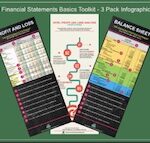Variance Basics Beginners Struggle With
If you are a hotel manager of a property, performance and variance analysis is one of your top priorities.
It is what your bosses are demanding from you.
Often though, hotel managers get distanced (or even consciously distance themselves) from the monthly performance results.
Many leave that to their deputies.
Given this scenario, hotel managers tend to resort to what I call the Variance Hack!
The Variance Hack looks at nothing except the variance.
In short, treating performance variances in Profit & Loss Statement numbers as the holy grail.
Grab this EXCEL Spreadsheet
Don’t miss our 5 Killer Hotel KPIs Dashboard
Get this exclusive Excel Template that you can customize to create your own 5 Killer Hotel KPIs Dashboard
I mean, not just to assess performance but also to take financial decisions.
This is dangerous, to understate it!
Why is that you ask.
Let me explain.
But first, are you a victim of this syndrome?
In the process, these managers forget the critical basics that are the foundation of hotel performance analysis.
Which give entirely new meaning to variance analysis.
What are those fundamentals you cannot afford to ignore?
Let’s get right into it.
I will lay out the basics of hotel performance and variance analysis which no manager can afford to ignore.
It will ensure that you achieve your revenue and bottom line targets consistently.
In this post pandemic era, performance analysis is equivalent to survival of the business itself.
Are you prepared for this post pandemic challenge?
This is Part 5 of the 6 Part Series on Hotel Profit and Loss Statement Basics Beginners Struggle with.
If you missed Parts 1, 2, 3 and 4, click below to read those first.
This Blog Post will cover:
Profit and Loss Statement Variance as the Holy Grail for all ills
The Profit and Loss Statement (we will call it P&L Report from hereon) is the performance statement.
It is indicative of the business results of a month.
It tells you:
- how much revenue you earned,
- expenses you incurred and
- profit you retained in a month.
Did you notice something in that statement?
I said “indicative.”
So, what is the big deal, you are thinking.
Well, here is the big deal.
The P&L Report is often considered the holy grail and a cure for all ills.
In particular, performance variances hold a special place in this illusory remedy.
Hotel managers tend to use the variance number in the P&L Report as something written in stone.
In other words, they swear by variances as numbers which they can depend on to take decisions.
And here is where the big deal is.
Variances are merely indicative of a situation.
They certainly are not absolute numbers that can be relied upon entirely.
You are skeptical about that statement!
Let me clarify with an example.
EXAMPLE
Assume the Rooms department revenue variance is showing a positive number compared to the budget for the month.
You cannot immediately jump to the following conclusions:
- that you can use the same decisions you took in that month for all future months
- since the result is a positive variance.
Why not you ask?
Variance & The Cause Symptom Confusion
Well, because the variance is just a symptom.
A symptom that is the result of comparing two different numbers.
You still do not know what elements caused that positive variance.
Most critically, you should not confuse symptom for cause.
Have you heard of the physician who prescribed medicines based on what he merely and visually saw as the patient’s symptoms?
If not, read on.
You may well be enlightened.
A physician prescribed fever medicines to a patient based on symptoms he saw - the patient was sweating profusely and his face looked pale.
He never bothered to find out the cause of the symptom.
Why was he sweating so much?
It turned out later that the patient was sweating so much because:
- first, he had walked to the clinic in blistering temperatures outside and
- moreover, he was prone to sweating a lot.
However, despite the symptoms, he did not run temperature or actually have fever.
The physician had confused his symptom (sweating) for the cause (fever) and prescribed medicines.
See, how dangerous it can be to jump to conclusions based on symptoms rather than determining cause?
So, how do you determine cause in the hotel operation, you ask puzzled?
Hang on, I am coming to that.
The Mathematical Story in a Variance
Let me give you another powerful reason why variances are dangerous.
And should not be relied upon without further verification.
Consider what the variance is actually showing.
Let us go back to that Room revenue positive variance.
The positive variance is a number which is a result of:
- deducting the actual revenue
- from budget revenue
In this case, actual was higher than the budget.
Hence the positive variance.
But the positive variance itself does not tell you anything.
All it tells you is that one number is higher or lower than the other.
So, what does tell you the real situation you ask.
All in good time.
The Search for Cause in a Variance
For you to get to the bottom of things you need to search out the cause for the positive variance.
That means studying both the actual and the budget numbers.
Why both, you ask puzzled.
Because, there are quite a few scenarios that could be the cause.
Here are a few such scenarios:
- The budget might have been grossly understated making the actual number appear higher than normal
- The actual might have been triggered by an abnormal event in the month
- The abnormal event will not repeat itself (and hence cannot be relied upon to take similar decisions)
The above are just two scenarios that should be considered.
We have not even begun digging into how actual revenue was contributed to.
You need to dive into the hotel operation for that.
For example, how much did occupancy increase?
Or how much did average rate increase?
It is also quite possible that:
- either the occupancy or
- the average rate moved in opposite directions and
- yet produced a positive variance.
So, there could be numerous scenarios that produced the positive variance.
The moral of the story is the same: determine the cause and do not look at just the variance.
Variance and The Cause Effect Symptom Phenomenon
Using the earlier example of the positive room revenue variance, let us now add an additional element to our discussion on cause and symptom.
That is the effect.
You look totally baffled.
Allow me to clear the clouds of doubt.
In the positive variance example (and in any variance situation for that matter) there are three parts:
- Symptom - the positive variance number
- Cause - the reason why there is a positive variance
- Effect - the actual room revenue (which is higher than the budget room revenue causing the positive variance)
In looking at these three parts, the effect and the symptom are the ones that are obvious.
From looking at the Rooms department P&L Report for a month, you can:
- see the actual room revenue (effect) and
- the positive variance from the budget room revenue (symptom).
The elusive part is the cause.
It requires further analysis.
Of the hotel operation.
It is also the part that will shed light on why the positive room revenue variance happened in the first place.
It is only after the why is determined that a decision can be taken using that cause.
A decision cannot be taken on either:
- a symptom (variance) or
- effect (actual revenue)
The cause is supreme.
The cause validates the effect and the symptom.
Digging into cause is an involved process.
It requires that you:
- First, determine all elements of the hotel operation that influence effect
- Second, find out how much each element impacts effect and
- Third, whether the elements can be used in future for decision making
Variance Recap
Let us now do a recap of what basic factors of hotel variances that managers and beginners often struggle with.
- Variance is a symptom and merely indicative of performance
- What caused the variance is more important
- Decisions need to be made based on cause rather than the variance (or the effect).
So, there you go.
The basics of hotel performance variances that beginners must understand thoroughly before analyzing.
Coming Next Week….Part 6 of 6
How do you read your hotel Profit and Loss Statement?
Do you consider three key factors before reading this important financial statement?
In Part 6 of this six part series on hotel profit and loss statement basics, we will bring all 5 parts of this series together.
We will discover powerful yet simple basics to reading a hotel profit and loss statement.
We will see what basics of reading a hotel profit and loss statement beginners struggle with most.
Sign Up for More Tips, Strategies and Secrets
Sign up to the Financial Skills Building Newsletter for more tips, strategies and secrets straight to your inbox.
7




